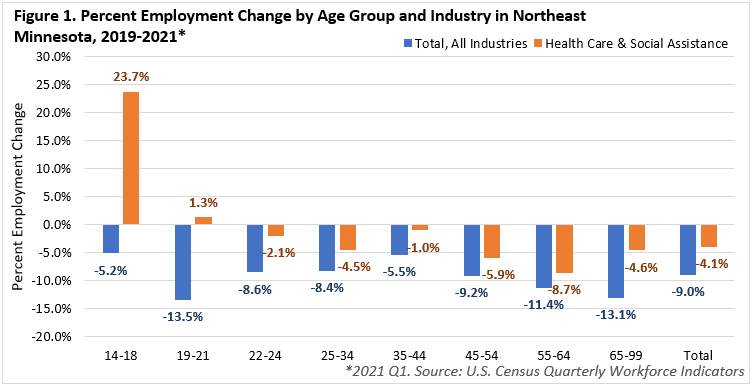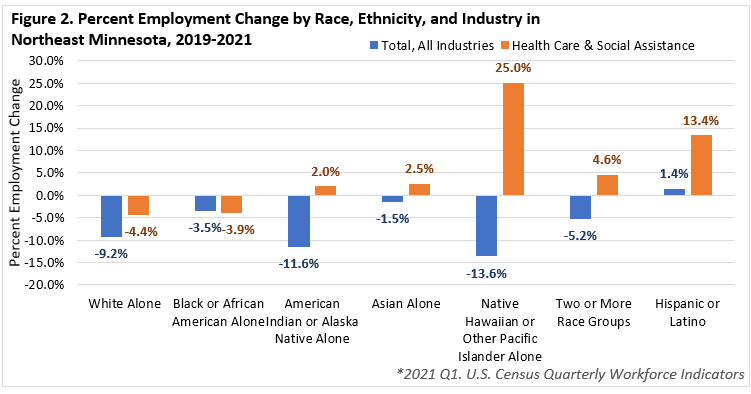 Home to the state's second-largest metro, the Northeast Region has a strong industrial sector, tied largely to the area's abundant natural resources.
Home to the state's second-largest metro, the Northeast Region has a strong industrial sector, tied largely to the area's abundant natural resources.
Most of the manufacturing base centers on mining and forest products industries. More than half of the sector's employment is in paper and machinery manufacturing.
Want the freshest data delivered by email? Subscribe to our regional newsletters.
12/27/2021 9:00:00 AM
Carson Gorecki
The upheaval of the COVID-19 pandemic has stretched far and wide across the economy. At the center of the fight against the virus, workers in the health care sector have repeatedly answered the call under continued stress. The pressure has almost certainly taken its toll on health care workers and there are a record number of job openings both from increased demand and the need to replace workers who have retired or otherwise left the industry. As of the 2nd quarter of 2021 there were over 4,500 Health Care & Social Assistance job vacancies in Northeast Minnesota, accounting for 35% of all openings in the region. These openings represent an abundance of opportunities for jobseekers ready and willing to take advantage, including many that historically have been less represented in the Health Care workforce, including a larger percentage of younger workers.
From 2019 to the 2nd quarter of 2021, total employment in Northeast Minnesota fell by nearly 12,000 jobs or -8.1%. The Health Care & Social Assistance sector proved more resilient, falling by just -5.0% (-1,750 jobs) over the same period, according to DEED's Quarterly Census of Employment and Wages (QCEW). Much of this resilience may have been rooted in the simple fact that workers in the health care sector are absolutely essential in the fight against the virus. The sector's integral position not only during the pandemic but as our population continues to age cements it as a safe bet for those looking for a long-term career. And younger and more diverse workers have taken notice, seizing opportunities at higher rates than other worker groups over the past year and a half.
The U.S. Census Bureau's Quarterly Workforce Indicators program provides employment levels by age, race, ethnicity, and sex by detailed industries and geographies. Using this information, we can see some interesting trends in health care employment over the course of the pandemic. As of the 1st quarter of 2021 in Health Care & Social Assistance, most age groups had experienced employment loss. The two exceptions were the two youngest age groups, 14-18 and 19-21. In fact, the youngest age group bucked the overall trend of employment decline by expanding over 23%, indicating that while many workers were re-assessing work or their positions, those newest to the workforce were grabbing open positions in health care with both hands (see Figure 1).

The overall impact on the health care workforce was relatively small, given that workers aged 14-18 accounted for only 1.8% of all workers in the sector in 2021 – but that was up from 1.4% in 2019. And while teenage workers did not experience job loss at the same rates as older workers across all industries, this trend was magnified in health care.
Like the youngest workers, workers of color also saw their shares of jobs in Health Care & Social Assistance increase from 2019 to 2021. Each non-white group of workers either declined less (Black or African Americans) or increased more over the pandemic period (see Figure 2). This is a continuation of the longer-term trend of a diversifying population and workforce in Northeast Minnesota. Since 2011, workers of color have increased over 46% across all industries. In Health Care & Social Assistance, this increase was an even larger 66%. Since 2019, the largest percent increase occurred for Native Hawaiian or Other Pacific Islanders, though that is also the smallest racial group. The largest absolute increase in Health Care and Social Assistance occurred for Hispanic or Latino workers.

The turmoil across the economy has been thorough and undeniable. The overall trend thus far has been one of employment loss and gradual recovery. Health care, while dodging some of the worst employment loss experienced by other sectors, nevertheless has also been impacted. Yet within the disruption there have been notable bright spots as new workers seize on opportunities created by the churn in the sector.
Workers of color and younger workers have joined health care at faster rates, suggesting that for those groups health care remains an appealing sector. With job vacancies at an all-time high, there continue to be plenty of opportunities for job seekers who want them.
To learn more about Health Care Month in Minnesota, visit careerforcemn.com/HealthCare. This page includes resources for job seekers, students and educators and employers. For example, numerous hiring events and career fairs are happening throughout the month of January for those looking for work in the health care industry. Employers can also find additional resources for attracting, developing, and retaining talent online here.
Contact Northeast Minnesota Labor Market Analyst Carson Gorecki at 218-302-8413.